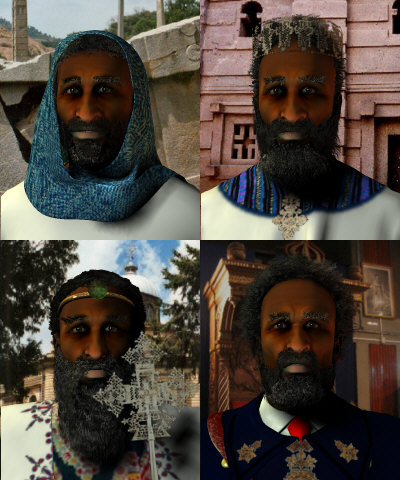I'll take a leaf out of Civ Army's book and give you some suggestions on how this civ could be used.
Leader title: Negusä Nägäst
Leader name: Haile Selassie
Traits: Religious and Seafaring
Aggression: 3 (moderate)
Cultural group: Middle Eastern
Favoured/shunned governments: Monarchy/Communism
UU: Ethiopian Javelineer (replaces Longbowman) or Shiro’s
Ethiopian Horseman (replaces Knight)
Military leaders:
Zara Yeqob
Amda Siyon
Baeda Maryam
Eskender
Naod
Tzaga Chrisus
Scientific leaders:
Ewostatewos
Azazh Gera
Takla Haymanot
Azazh Raguel
Cities:
Axum
Adulis
Massawa
Tana Kirkos
Tiya
Jimma
Tugulet
Roha
Mitsiwa
Debre Birhan
Guba’e
Gonder
Gorgora
Mekele
Addis Ababa
Zaila
Dahlak
Nasi
Napata
Djbout
Asmara
Bahir Dar
Gamud
Debre Tabor
Asosa
Gambela
Adis Zemen
Nazret
Megalo
Gode
Werder
Geladi
Dolo
Maji
Murle
Tulu Welel
Gimbi
Nejo
Imi
Himora
Randa
Napata
Degeh Bur
Dese
Yabelo
Civilopedia entry:
#RACE_ETHIOPIA
^
^Ethiopia had its roots in the ancient Axumite civilisation,
which was based around the great city of Axum near the Red Sea coast.
This civilisation, based on Red Sea trade, became powerful in the centuries before the time of Jesus -
according to the lost epic "Ethiopis" of Arktinos of Militos, the Axumites fought with the Trojans against the Greeks.
They believed passionately in its close links with the ancient Israelites -
for according to Axumite legend, their people were descended from Hebrews who fled Egypt at the time of Moses.
The Axumites were the only African civilisation south of Egypt to develop writing,
and the city of Axum itself was one of the most splendid in the ancient world.
It traded ivory and other goods with the Ptolemies in Egypt from the third century BC onwards.
Ethnically, the Axumites were Hamitic, and like the Egyptians saw themselves as "red people" ,
distinct from the "black people" of neighbouring Nubia.
^
^Christianity came to Ethiopia in the fourth century AD, and it was strongly entrenched
by the sixth century, although Judaism still remained strong in many areas.
Indeed, Ethiopian Christianity always retained a strong Jewish flavour,
with the survival of customs such as circumcision.
The church also retained its links with Egypt, since the head of the Ethiopian church, the abana,
was always sent from Egypt. But it quickly developed its own identity.
witih church services conducted in Ge’ez,
the language of Axum.
Many monasteries were built, including the famous Debre Damo, built on the site of an old pagan shrine.
Like many monasteries in the country, Debre Damo was built on an almost unclimbable mountain top,
reachable only with the aid of a copper cable.
^
^The coming of Islam to Arabia and Africa shook Ethiopia to its core.
Relations with the Arabs were hostile from the outset, with fierce fighting on the Red Sea.
However, the Muslims fought back, and by the eighth century the Ethiopians had been driven from Arabia,
their ships had been cast out of the Red Sea, and their ports had been captured or destroyed.
Ethiopia did later recapture some ports and build a new fleet, but it was no longer a great maritime power.
#DESC_RACE_ETHIOPIA
^The people abandoned Axum and retreated to the mountains.
As they did so, they came to rule new peoples,
including the pastoral Agew people, who spoke a different language - although they were Christians.
The overstretched Ethiopian army was unable to control its territory,
and an Agew dynasty, the Zagwes, seized power. Regarded as usurpers by many, especially within the church,
the Zagwes were very keen to establish their ancient credentials,
even inventing a story that they were descended from Moses. The most famous Agew king was Lalibela,
who ruled in the early thirteenth century. He built a new capital at Roha, which he envisaged as a new Jerusalem -
he even named the nearby river Jordan. Here, Lalibela commissioned a series of eleven churches
carved out of the rock itself, in an effort to prove his Christian commitment.
Roha has long since dwindled, but is now known as Lalibela,
and the churches there are one of the most remarkable monuments in Africa.
^
^The Zagwes did not last long. They bickered among themselves, and were unable to hold the empire together.
A rebellion in Shewa received ecclesiastical support and successfully overthrew them in 1270
when the Shewan king, Yekuno Amlak, murdered the Zagwe emperor in front of a church altar and took his title.
But the country now entered something of a golden age.
Under the great emperor Amda Siyon, who ruled from 1314 to 1344, Ethiopia developed a more effective feudal administration,
the church was revitalised, and the Muslim states that threatened it, particularly Yifat,
were conquered in a series of brilliant military campaigns.
^
^Ethiopia's strength did not last. Wars with the Muslim states of Adal and Yifat in the sixteenth century
brought the empire to its knees, rescued only by Portuguese intervention. Religious disagreements
with the Portuguese led to Ethiopia closing its doors to the outside world
until the nineteenth century. The 1930s saw Ethiopia briefly subjugated by foreigners for the only time in its history when Mussolini invaded. The emperor, {Haile Selassie},
personally led his troops in battle against the Italians before taking his nation’s case to the
UN. After WWII, Haile Selassie was reinstated and personified Ethiopia until the 1970s,
when a coup saw him arrested and (probably) murdered. Only now
did the centuries-old empire cease to exist, becoming (briefly) a communist state
and then a modern democracy.




 WOOOOOOOOOOOOOOOOOOOHOOOOOOOOOOOOOOOOOOO
WOOOOOOOOOOOOOOOOOOOHOOOOOOOOOOOOOOOOOOO

 , I hope this is only the beginning of a great career
, I hope this is only the beginning of a great career 

